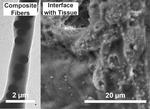Recent & Upcoming Talks
2019
Intrinsically Adhesive Polymer Wound Dressing with Antimicrobial Properties
Conventional wound dressings are adhesive-coated thin films. They adhere primarily to healthy skin surrounding the wound, and have limited exudate absorption. Here, we demonstrate that polymer blend fibers can be sprayed directly into a partial-thickness skin wound using solution blow spinning, a fiber spinning technique. Due to a body temperature-mediated softening event, the fibrous wound dressing can stick immediately to the wound and skin. Within 3 days, the porous wound dressing has absorbed a significant amount of wound exudate, creating a polymer-scab hybrid material that is strongly bound to the wound. As a result, this wound dressing required 75% fewer dressing changes than a clinical control wound dressing. We tracked a number of additional wound healing metrics. Vascularization, as measured by blood vessel density in the healing wound, was significantly increased. Dermis and epidermis thickness, collagen content, and various gene and cytokine expression levels were comparable between dressings. We also engineered the controlled release of silver nitrate, a potent antimicrobial agent, without compromising adhesion or cytotoxicity.
2018
Adhesive Polymer Composite Wound Dressings: Silver and Silica for Antimicrobial and Hemostatic Applications
Wound closure devices prevent excessive blood loss and exposure to pathogens, whether for internal or external use. Conformal, adhesive dressings improve upon conventional wound closure devices such as sutures by minimizing collateral damage to tissue and providing a leak-proof seal. In this work, we demonstrate how solution blow spinning (SBS) can be used to spray-deliver polymer composite dressings in situ–and how the composite element delivers advanced functionality, either by (1) releasing silver ions to prevent infection or (2) by incorporating silica particles to reduce coagulation time. Both approaches utilize a body temperature-responsive biodegradable polymer blend of poly(lactic-co-glycolic acid) and poly(ethylene glycol) (PLGA/PEG) with minimal cytotoxicity.
Incorporating silica particles improves the adhesion, flexibility, and hemostatic efficacy of a polymer blend surgical sealant
Surgical sealants are supplements to conventional wound closure devices that augment hemostasis and may reduce complication rate. However, commercially available surgical sealants adhere poorly to wet tissue and are difficult to apply precisely. Here, solution blow spinning (SBS) serves as a sprayable deposition method for easily depositing conformal surgical sealants directly to the wound. The objective of this research is to increase tissue adhesion by incorporating nano-to-microscale particles into a poly(lactic-co-glycolic) acid and poly(ethylene glycol) blend sealant (PLGA/PEG) whose deposition is compatible with SBS. Our experiments focus on understanding how the silica particles interact at the interface with tissue, measuring adhesive interactions, and determining possible mechanisms for adhesion improvement which may be of broader interest to the field of surface science. Adhesion increases dramatically by incorporating silica particles into the PLGA/PEG blend surgical sealant, but does not cause a significant decrease in cell viability. Composite PLGA/PEG/SiO2 sealants produce intestinal burst pressures that are comparable to cyanoacrylate glue (156 mmHg), ~2 times greater than PLGA/PEG (59 mmHg), and ~3 times greater than fibrin glue (48.6 mmHg). Adhesive force increases by 20% while adhesion energy, which takes into account work dissipated by the bulk of the sealant, is 20 times higher. Scanning electron microscopy shows silica particles sandwiched at the interface between tissue and sealant, where they create dense networks of physical bonds. These improvements demonstrate the potential of a simple composite design to increase adhesion through physical, noncovalent mechanisms.
2017
Functionalized Biodegradable Polymer Surgical Sealant for Bowel Anastomoses
Surgical sealants reduce the risk of anastomotic leaks that may cause expensive, high mortality rate complications such as sepsis. Using a polymer nanofiber deposition method called solution blow spinning (SBS), we have developed sprayable fibrous coatings that soften due to a body temperature-mediated thermal transition. Poly(lactic-co-glycolic acid) (PLGA) was blended with poly(ethylene glycol) (PEG) in varying ratios in solution to increase tissue adhesion. We used this solution to fabricate fiber mats using SBS, and showed that PEG increases fiber diameter and affects fiber morphology. Increasing PEG content decreases the glass transition temperature of the material and creates a melting event at 31°C, which occurs after the material is applied to the body. Temperature controlled pull-off testing demonstrated increased tissue adhesive forces at body temperature. The degradation of this material was monitored for 28 days and compared to PLGA. Adhesive forces and burst pressures measured on ex vivo intestinal tissue at body temperature increased relative to PLGA fibers. In vivo testing of an optimized PLGA-PEG blend as a supplement to sutures in a leaky anastomosis mouse model showed increased burst pressure and improved survival rate compared to clinically-relevant controls. This blend could be deposited in situ directly to the site of surgery using an airbrush and changed from white to translucent after application, augmenting usability. We also evaluated PLGA-PEG as a coating for a no-suture anastomosis, where it performed similarly to cyanoacrylate glue (“superglue”) with reduced inflammation.

